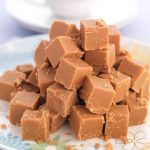 A soft creamy candy consisting of milk, sugar, butter and flavorings.
A soft creamy candy consisting of milk, sugar, butter and flavorings.
The candy now known as fudge was invented by accident in the late nineteenth century when a toffee recipe went awry and the main ingredient—sugar—recrystallized into a semi-soft mass. The new candy received its name from students in New England women’s colleges who turned fudge-making into an all-night bonding ritual, and fudge-selling into a means of funding their colleges’ social events. The students likely chose the name fudge because the word had been used, since the middle of the eighteenth century, as a mild exclamation—Oh fudge!—of surprise or disbelief. As well, since the middle of the sixteenth century, fudge had also been used as a verb to denote the action of patching something together, especially in a sneaky manner. This verb form of the word—which derives from a much older word, fadge, also meaning to patch together—is unrelated to the exclamation; however, its sense of pulling together various pieces is germane to the fudge-making process, so it too may have inspired someone to name the new candy fudge.
A smooth and luscious confectionery that is typically made with chocolate and often combined with nutmeats is commonly referred to as a creamy candy.
Fudge is a confection made from a blend of sugar, butter, milk, and cream, in varying proportions. It can be prepared in several flavors, such as chocolate, vanilla, and honey, and is often embellished with chopped nuts, dried or candied fruits. The mixture is heated to a temperature of approximately 240°, and then continuously stirred until tiny crystals are formed. Stirring during the cooking process is essential to prevent burning. While the fudge is still in liquid form, it is poured into a greased pan, and as soon as it becomes firm, it is sliced into pieces.
